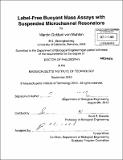Label-free buoyant mass assays with suspended microchannel resonators
Author(s)
Von Muhlen, Marcio Goldani
DownloadFull printable version (18.43Mb)
Other Contributors
Massachusetts Institute of Technology. Dept. of Biological Engineering.
Advisor
Scott R. Manalis.
Terms of use
Metadata
Show full item recordAbstract
Improved methods are needed for routine, inexpensive monitoring of biomarkers that could facilitate earlier detection and characterization of complex diseases like cancer. Development of new assay formats based on microfluidic, label-free platforms enable radical reductions in assay complexity and reagent requirements with the potential for such applications. Suspended microchannel resonators (SMRs) are highly sensitive, batch-fabricated microcantilevers with embedded microchannels that can measure mass with femtogram precision. Biomolecules such as proteins and nucleic acids are denser than water, and their presence can thus be quantified by their buoyant mass, or increase in mass relative to the solution they displace. This thesis presents two approaches to conducting label-free, buoyant-mass immunoassays with SMRs with potential for clinical applications. The sensor surface can be functionalized to bind targets directly, or individually weighed polystyrene beads can be used as mobile supports. As in other label-free detection methods, biomolecular measurements in complex media such as serum are challenging due to high background signals from non-specific binding. We demonstrate that carboxybetaine-derived polymers developed to adsorb directly onto SMR SiO2 surfaces act as ultra-low fouling and functionalizable surface coatings. Coupled with a reference microcantilever, this approach enables detection of activated leukocyte cell adhesion molecule (ALCAM), a model cancer biomarker, in undiluted serum with a limit of detection of 10 ng/mL. Decoupling the complexity of surface modifications from the sensor precludes the need for specialized reagents. Monodisperse, micron-scale polystyrene beads are widely available and can be used as mobile supports, with the mean mass of a bead population quantifying target binding onto bead surfaces. Inherent mass variability in the bead population is masked by matching solution density to bead density. We demonstrate that by weighing hundreds of beads in 30 min, mean mass can be estimated with a resolution of 100 attograms. A proof-of-principle assay is demonstrated that quantifies IgG binding onto functionalized beads at 5.20 femtograms per bead.
Description
Thesis (Ph. D.)--Massachusetts Institute of Technology, Dept. of Biological Engineering, 2010. Cataloged from PDF version of thesis. Includes bibliographical references (p. 105-112).
Date issued
2010Department
Massachusetts Institute of Technology. Department of Biological EngineeringPublisher
Massachusetts Institute of Technology
Keywords
Biological Engineering.